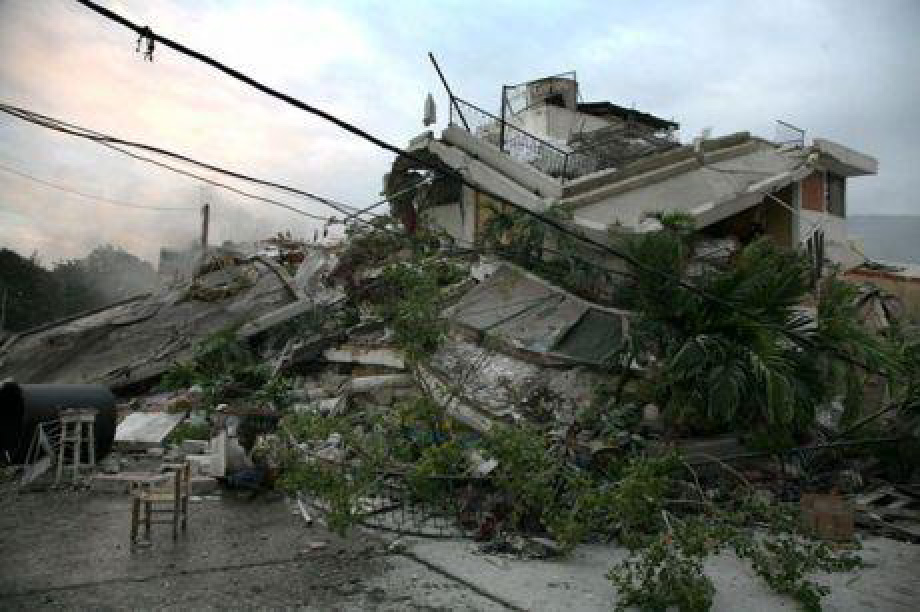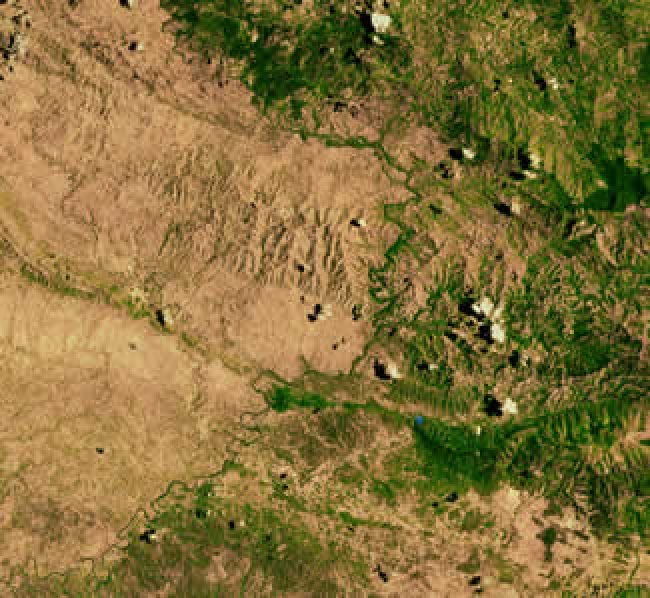
- Cyclones, une vulnérabilité très liée au développement FR ES
- Dérèglements climatiques et insularité FR ES
- La Soufrière de Saint-Vincent et les Grenadines FR
- Littoral des Petites Antilles (2007) FR
- Natural Hazards (1999)
- Natural Hazards (2011)
Haiti, or more precisely the region of Port-au-Prince, destroyed, devastated, with a death toll of certainly over 250 000 people, the exact number will never be known. This represents some 3% of the country’s resident population. One city, the capital encompassing the state’s whole political, economic and administrative infrastructure, is laid waste. The south of the island, around the epicentre is also seriously affected. Jacmel, a UNESCO world heritage site is 80% destroyed, and the towns and villages strung along the peninsula west towards Jamaica in the state of ruin. Coastal subsidence has allowed the invasion of the sea inland, and several villages are now permanently under water. Sickness and injury will increase, as well as rates of mortality.
The year 2009 was cyclone-free, but recommenced with a vengeance in November 2010 with cyclone Thomas, causing around 20 deaths, to which should be added a further 3 000 individuals, mainly children, due to a cholera epidemic. The earthquake of 12 January 2010, is a general reminder that the Caribbean is one of the regions of the globe plagued by such curses. At this time of writing, Guatemala is being crossed by a tropical hurricane, flooding its low-lying land, a volcano has erupted, with town and countryside covered in ash; whilst in October, landslides would carry away villages in Mexico and Colombia. So just when it seemed (but can one ever be sure?) that Haiti was experiencing better times, the earthquake reduced everything to rubble. How does one rebuild? What does one rebuild? Where does one rebuild?
Far, very far away from Haiti, it seems presumptuous to offer lessons, even advice. But studying the region, as a close observer for more than 35 years, pushes me towards sharing a few thoughts. The topmost priority must be founded on three pillars.
1. A rethought and managed population distribution
Since the earthquake, a number of observers, including it seems, some Haitian politicians have envisaged a reorientation in the distribution of population. Several experts have suggested the development of medium-sized towns, a re-balancing of the existing urban concentrations. In effect, Port-au-Prince, in keeping with most Caribbean capitals, accounts for more than one-third of Haiti’s population (2.7 million inhabitants, but given the ring of shanty towns encircling the central city, this total represents an undoubted under-estimate). This challenge to achieve a better population distribution can only succeed if it is accompanied by a re-peopling of the countryside, at the same time in tandem with the security of their welfare:
- Security of supplies from the countryside to the towns so that local markets resume their former role. At a time when economising on energy consumption has become a bi-word, there is a need to exploit the advantage of proximity, and accordingly to reactivate, develop, the role of the market towns and medium sized urban centres. In 1998, Kenscoff was still a prospering market gardening region where the altitude permitted with tropical cultivation and temperate zone production of vegetables and fruit (artichokes, peaches, apricots, and obviously lettuces and carrots...). Kenscoff is not the only locality where it is possible to practise market gardening. Today one tends to have forgotten, because of the disasters of recent decades, just how prosperous Artibonite had become has a rice growing region, as well as producing sugar cane and coffee. The development of the road transport network would provide peasant farmers with the secure means for distributing their produce, as long as prohibitive customs tariffs prevented the influx of cheap American maize or wheat from Europe.
- Security in terms of healthcare and education. Only easy transport access will encourage the diffusion of public dispensaries, often controlled by charitable associations or doctors. The latter, opnly too few in number, are primarily located in the towns. It is also in these market towns that schools have been established. One cannot hope for any improvements in literacy if getting to school each morning remains an odyssey for the rural children.
- Security of the rural population itself as long as the forces of law and order are not impeded in their response to calls for assistance.
- Security, finally, of the various goods and supplies provided by the rural artisans, whose extraordinary talents are well known.
Clearly, one would need equally to envisage a dense subsidiary route network connecting the hamlets to the main tarmacked highways. In 1980, the distance between Port-au-Prince to Cap-Haïtien could be covered in 4 to 5 hours. In 1998, after one journey, some drivers were suggesting that the big northern town could not be reached in less than two days. Perhaps that was an exaggeration, but all the same, one had to envisage a journey-time of 14-15 hours. Security wise, the presence of gangs, and the state of the roads prevented driving at night, hence the suggested minimum journey time of two days. Similarly, driving to the southern-most point of the island, or western-most, represented a real expedition. It was only five days after the earthquake that the first reports became available from the towns of the southwest: as for visual images, these were distributed some seven days later. A network of effective communications becomes a basic land management requirement. The populations who fled Port-au-Prince in the days following the earthquake will only remain in the countryside if the latter is seen to experience real development guaranteeing supplies of food, sanitation, and other human needs for those opting to stay.
2. A just management of the environment
This second pillar of any reconstruction would constitute a veritable regional rescue plan. Nothing is more impressive in this regard than overflying Hispaniola. The frontier is visible from an altitude of 8 000 metres: to the East, a bleak landscape more or less covered in forest, to the West, a desert, the exposed soil and the deep ravines lining the flanks of the mountains.
Before the point is reached where only rock surfaces remain on which nothing will grow, forests will need to be replanted. Such strategies have been undertaken in other parts of the world, prompted by both national institutes and above all the NGO in association with local actors: in this respect, both Madagascar and India provide exemplary successes, albeit still at an embryonic stage. In Haiti, reforestation schemes are underway in several zones. A number of NGOs and international institutions have intervened, but there is a lack of coordination in the actions taken, and especially in the involvement of the Haitians themselves. The Caribbean region affords some examples of solid experience in the management of forests, whether in Costa Rica, Cuba, or in the Lesser Antilles like Dominica, Martinique, or Guadeloupe. One can also record that numerous island societies have survived, and thrived, thanks to the coconut palm, mango tree, or breadfruit. All that species demand little in upkeep, apart from during the early years when the young shoots require protection from predators. Now the Haitian peasants are familiar with, manage, and understand the value of these species. Many rural houses are surrounded by these trees, which provide a source of food in addition of the banana tree. It is from such a knowledge base that a systematic replanting can be successfully undertaken. Providing direct aid to the farmers is one of the possible ways forward. Reforestation should also be planned using both quick-growing-tree species (Nicaragua Pine), and those more slow growing: specialists are present in the region, and nurseries plentiful.
In order to succeed, the reforestation plan must necessarily mobilise the Haitians themselves. Several mayors of Haitian communes, at a meeting held in Fort-de-France during the latter part of April 2010 regretted that a number of projects had proceeded without their involvement. The councillors themselves are capable of mobilising the support of the inhabitants, organising reforestation schemes involving specialists in tropical forestry, as well as the NGOs and other foundations. They are best placed to engage young pupils and other adolescents in large-scale campaigns for reforestation.
Reforestation will not prove effective unless it offers the possibility to poorer sections of the population of using alternative sources of fuel to cook meals. One Haitian social evil has centered on trade in timber (exports, for example, of logwood to the USA) as well as the production of charcoal, which remains the sole source of fuel for millions of Haitians who live on less than a dollar a day, and also is a source of income for the peasantry. Reforestation must be accompanied by access to butane or propane gas, at a manageable cost (comparable, say, to that of charcoal). If the monetary aid received in the aftermath of the earthquake could serve to create a market for a gas alternative, then reforestation might be viewed as a realisable project. The commercial organisation of such a network is complex, and is why the rebuilding of road transport links and reforestation must proceed in tandem. Suffice it to say, that the stockpiling of gas, its maintenance and distribution will create in itself trades, training and jobs in an island that has need of them.
3. The stakes over drinking water supply
The above notes initially date back to February 2010, and were further expanded in November 2010. The problem of over drinking water supply brutally come to a head again in September 2010, during the rainy season, with the onset of a cholera epidemic, a fear that had been ever present since the earthquake, even though Haiti had been spared during similar cataclysmic events in its history from the multiple ravages caused by the cholera bacillus. Port-au-Prince is still in ruins: the roads are stoved in, the debris yet to be removed, a large part of the population still housed in tents, or ad hoc shelters that cannot resist violent rains. The drinking water supply and distribution systems, already inefficient, were affected by the earthquake. That for evacuating wastewater was already virtually inoperable. The town in large part was built on mangrove and marshy swamp, poorly drained, with the stagnant water favouring microbic proliferation. This epidemic sadly had something ineluctable about it, even though there are those who suggest it was brought in by Nepalese soldiers from MINUSTAH (United Nations Stabilization Mission in Haiti). Nepal has suffered cholera outbreaks in recent years. With the wastewater outlets virtually non-existent in Port-au-Prince and even less so in the smaller agglomerations, the effluent of the troops ended up in the Artibonite.
Reconstructing, indeed in some cases constructing anew piped water distribution and sewage networks, remains a priority. The problems posed by the cost of water is an ever present issue. Already in 2000, the civic authorities in the capital had decided to impose water charges. Poor inhabitants responded by piercing the main supply pipes, and water flowed freely in the town’s streets. What solution could there be in such a situation? Would it be cheaper to freely accessible public water fountains? It is a debate that the inhabitants and authorities, as well as international organisations need to engage with. But Haiti will only succeed in its rebuilding programme if its inhabitants are willing to work, and have the energy for what promises to be a long and arduous combat in terms of redevelopment.
For the Association of Caribbean States (ACS), it would seem that here is a real project for cooperation, that this organisation is well-placed to seek international engagement, in order to find the necessary funding over the next 10 to 15 years in order to help the political leadership in question to embrace the necessary structural reforms.
top
|
  |














